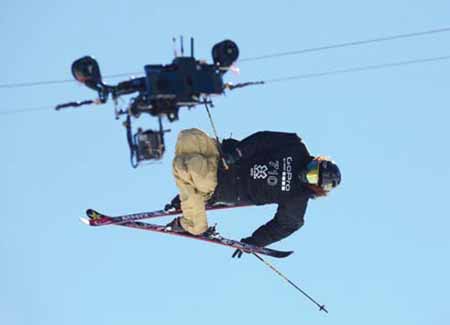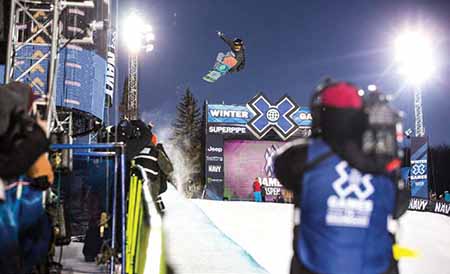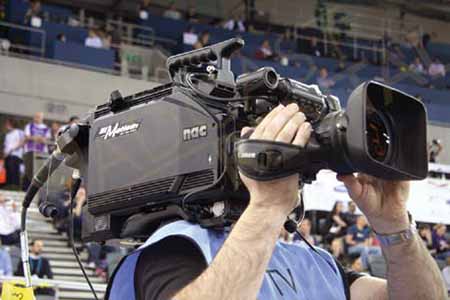Tech Takes to the Hills at 2015 Winter X Games

A followcam captures Matt Walker as he competes in the Men’s Ski SlopeStyle Elimination at Winter X Games 2014.
ASPEN, COLO.—From the very beginning, the X Games were not your father’s winter sports event.
In the 17 years since its inception, the Winter X Games has evolved from a quaint local event for a smattering of snowboarders into an industry of its own—spawning a new language, lexicon and new events themselves, and opening the door for previously unheard of events that sometimes end up as part of the Winter Olympic Games.
LOGISTICAL CHALLENGES
This year, the X Games winter sports and youth lifestyle festival returns to Buttermilk Mountain in Aspen Snowmass, Colo., Jan. 22–25, with an expanded lineup of skiing, snowboarding and snowmobiling events. Returning this year are Snowmobile Hill-Cross and Speed & Style events, as well as new events such as the Snowboarder X Adaptive discipline.
The games will be covered live on ESPN and ABC as well as across digital platforms using a mix of traditional and innovative new broadcast technology.
The networks will be using six production trucks from NEP, including the SS22 and SS32 A and B units, which include Calrec Apollo audio consoles, Sony HDC-1500 cameras, EVS XT2 servers and a Grass Valley Kayenne switcher. The network will also use the NEP ST28 truck for support and a BSI truck for RF coverage.
This year the networks are facing a number of logistical and technology challenges, according to Patricia Mattero, operations manager for ESPN Event Operations, including newly constructed parking lots at Buttermilk that added challenges to building out the TV compound. As the network’s truck and technical facilities grew this year, the nearby space has been reduced—and all will be well as long as the flakes don’t start coming down.
Get the TV Tech Newsletter
The professional video industry's #1 source for news, trends and product and tech information. Sign up below.
“The challenge will be if there is a snow-storm,” Mattero said. “In looking at the competition schedule, we have also been creative in how we will use our resources to cover SuperPipe and Big Air,” which are two of the games’ bigger events. These disciplines are being covered by the same production team as in year’s past, she said, and yet there will be two different sets of announcers and judges for these two disciplines, which tend to draw some of the biggest crowds of the games.
“Rather than have these two groups switching in and out of their seats, we will leverage the Snowmobile announce and judge facilities so that both groups can remain in one place for their respective events,” she said. “The new construction has allowed us an opportunity to install some permanent power and cable infrastructure in the base area, which will save us time both in setup and also enables us to eliminate some of the temporary truss that has been built in the past.”
NEW IN-HOUSE TECHNOLOGY

An ESPN cameraman follows Mason Aguirre as he competes in the Men’s Snowboard SuperPipe Elimination during Winter X Games 2014.
This year ESPN will employ newly developed technology from the network’s inhouse team. The moniker is a bit of a mouthful—camera sensor technology for virtual insertion—but it’s technology that’s already seen a great deal of success as part of ABC’s regular-season football coverage.
For football coverage, the technology has been used to impart a virtual scrimmage/first down line image on screen during live action football play. Industry-standard Vinten 750i instrumented heads are used along with signals from Fuji and Canon broadcast lenses to decipher the orientation of a camera. “It’s a technology that can be extended to any sport that requires virtual graphics,” she said.
Signals are then sent to an ESPN interface box that converts the analog and digital encoder signals into a serial datastream. That stream is modulated with an audio modem and sent to camera audio inputs so it can be transported on the existing triax from the camera to the main production area. Signals are extracted from the camera control unit in the production area and sent to ESPN’s VMagic system for processing.
“The VMagic system utilizes this information along with a state-of-the-art internal chromakeyer and renderer to display any virtual graphics in the scene,” Mattero said. Virtual graphics track with the background as the camera operator moves the camera, which results in a seamless image for the viewer. ESPN found the system robust enough to travel in a production truck; voila, it’s making its way for the first time to the Winter X Games.
IMAGING AND AUDIO ADVANCES

ESPN will use several NAC Image Technology High-Motion II ultra-slow motion HD systems at the 2015 Winter X Games.
In keeping in line with its alternative sports legacy, the games will also employ a number of unique cameras, including several NAC Image Technology High-Motion II ultra-slow motion HD systems, two FlyCam stabilized tracking camera systems that will be used on SlopeStyle and X Course competitions, four jib cameras on the Slope- Style and SuperPipe events, a Supercrane with attached HD camera, two Strada camera cranes, and three follow-cams for trailing competitors as they’re on the slopes.
To boost the audio experience this year, the network plans to use various microphones throughout course coverage, including different versions of the Sennheiser MKH416 and AT 8015 shotgun mics, Sennheiser MD46 stick mics, Sennheiser HSP 4 headset mics, Sony ECM 77 lavalieres as well as transducers. Effects microphones will be placed in and on the courses and routed from the mountain to OB vans through a network of more than 14 Hydranet field devices connected over fiber.
Susan Ashworth is the former editor of TV Technology. In addition to her work covering the broadcast television industry, she has served as editor of two housing finance magazines and written about topics as varied as education, radio, chess, music and sports. Outside of her life as a writer, she recently served as president of a local nonprofit organization supporting girls in baseball.

